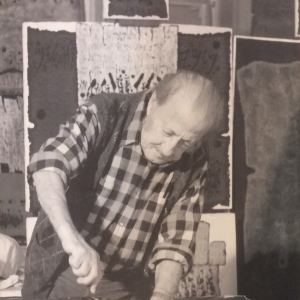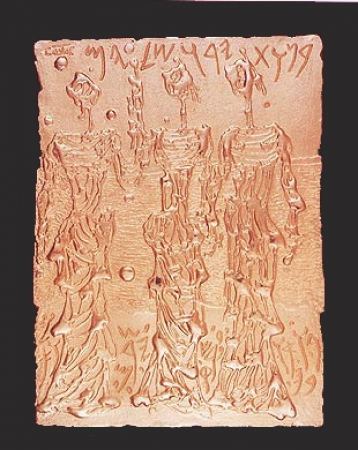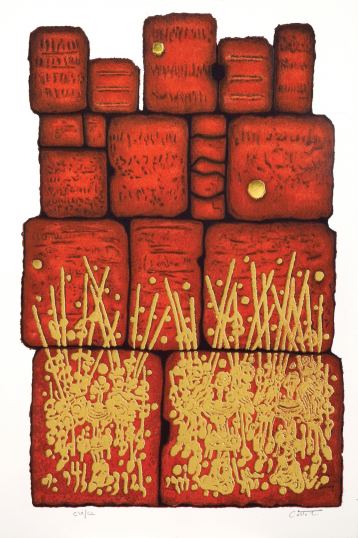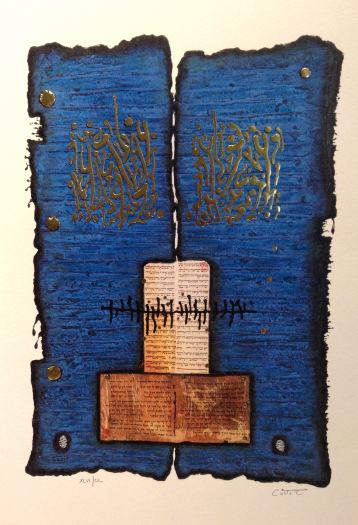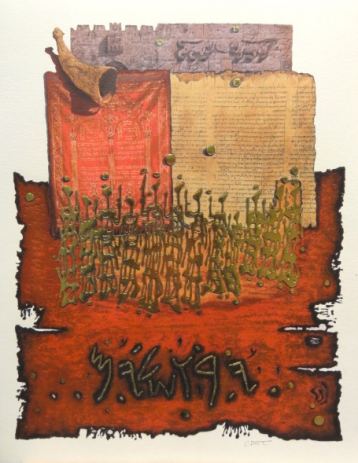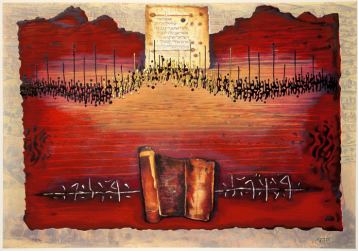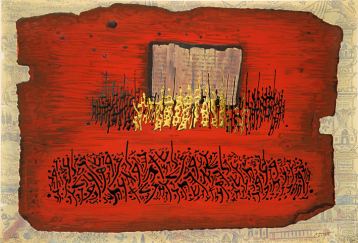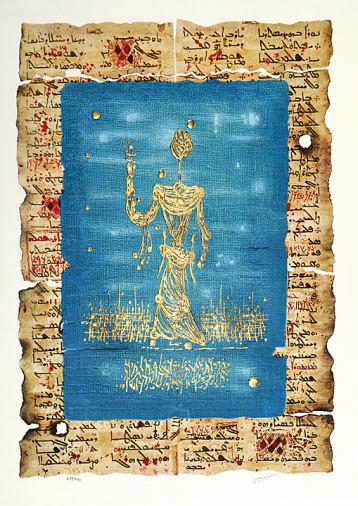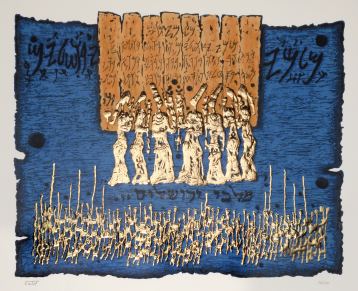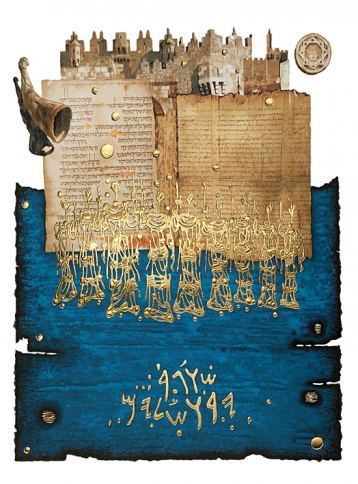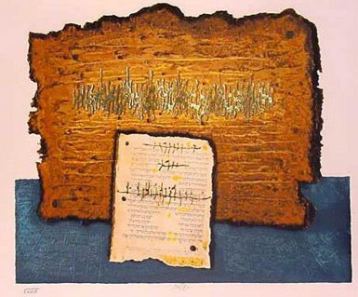Biography
Moshe Castel was born in Jerusalem in 1909 to his father, Rabbi Yehuda Castel, and his mother, Rachel, daughter of Yosef Ancona.
He quickly became one of the most famous israeli artists of the israeli art scene.
The Castel family arrived in Israel from Castile in 1492. The members of his family had settled over the years in Hebron, Gaza, and Jerusalem.
His father, Rabbi Yehuda Castel, was a scholar, skilled in writing Torah scrolls, and also made a living by designing decorated silk coverings for Torah scrolls as well as curtains for Holy Arks in synagogues. He opened a religious school for members of the Sefardic community in Nachalat Shiva, and later opened a religious school in the Bukharan quarter, where the family built their home at the periphery of the neighborhood.
Moshe Castel learned during his youth at his father’s school in the Bukharan quarter, and afterwards continued at a school for boys. When he was 13, he was accepted to study at the “Betzalel” Arts School, under the auspices of Boris Schatz. He studied there for three years, from 1921-1925. He was a talented artist and his works were displayed at the Israeli Artists’ Exhibit, which was held at the Tower of David in Jerusalem.
The education at “Betzalel” was not enough to cover the technical knowledge the young Moshe Castel sought, especially painting with oil paints.
Shmuel Ben David, an artist who had been Castel’s teacher and of whom he was very fond, encouraged him to travel to Paris. Ben David, who had studied in Paris at the Academie Julian was, apparently, the one who suggested that Castel learn there. The young Moshe told his parents of his desire to travel to Paris. His father refused the request, and as a result, Moshe was emotionally and physically distressed. His mother, Rachel, was the one who influenced his father to agree to his request, as he writes in his memoirs: “My mother said to my father – let him travel; he is sick, he is crazy about Paris. In the end, they let me go.” Castel arrived in Paris on a freight ship that set sail from Jaffa to Beirut, and from there, via Cyprus, to France. The presence of his brother, Yosef, in Paris, eased his acclimation.
During his first days, he wore fancy clothing, a black hat, and a black tie, because he thought these made him look like an artist. Quickly enough, he took off these clothes and dressed, in his words, like a “vagabond.” Moshe Castel studied at the Academie Julian, the Academy Chomier, and at the Louvre Museum. At the Louvre, he sat before the works of Rembrandt, Velasquez, Delacroix, and Courbet, and copied their paintings, paying attention to the technique of layering the paint on the canvas.
There he learned, in his words: “That art is not symbolic, but rather material, the material is the main thing, the way the paint is placed, the way the layers are placed on the picture, this is the most essential thing.” Castel worked to earn a living during the day, and painted at night. His first studio in Paris was on 46 Hippolyte Mandron in Montparnasse. The studio was located in a small courtyard, which was shared by him and a sculptor who later became famous, Giacometti. In May of 1927, he held his first exhibition, sponsored by the World Union of Hebrew Youth and by the senator, Justin Godard. The exhibition took place in the main hall of the union at 22 San Dani Boulevard in Paris. Zev Jabotinsky, who was at the time in Paris, heard of the young artist from Jerusalem and came to visit and encourage him, writing an introduction for the exhibition’s catalogue.
Castel’s creations were displayed at important salons in Paris – the Salon d’Automne, Salon Galerie De France, Salon Manti, and at Galerie Zborowski, in whose merit he was exposed to known artists such as Modigliani, Soutine, Utrillo, and others. Zborowski was the one who suggested that Moshe Castel sign his words with the name “Castel” alone, dropping the “Moshe.” The most important gallery for Castel was Galerie Jacques, with whom he signed a three-year contract, according to which the gallery bought all of his works from him. Between the years of 1929-1930, his works were displayed at special exhibitions that were held in London.
In 1931, his works were displayed at a group exhibition in Warsaw, at Salon Dorozgeni.
In 1933, he held a solo exhibition at the Technion in Haifa. Regarding his stay in Paris, Castel said: “Paris was especially for me a springboard to my selfhood.” In his first years in Paris, he did not forget the landscapes of the land of Israel, and they appeared as an important subject of his works. He writes in his memoirs that he once painted women, and told a famous art critic, who saw the painting, that he was painting French women. The critic said to him: “These are not French women; they are Jerusalemite women.”
In 1934, Castel came to Israel for a vacation in his homeland.
In 1936, he came for another vacation and lived in Tel Aviv. He rented a small basement in a building on 16 Mapu Street, which was owned by the artist, Yosef Zaritsky. He turned the basement into a studio. Castel, who had mastered while in Paris the art of painting with oil paints, taught Zaritsky, who had until then painted with watercolors. Another artist, Menachem Shemi, was one of his students as well.
In 1936, he initiated the first exhibition of Parisian style artists and for the first time, brought to Tel Aviv paintings by Soutine, Kissling, Chagall, and others.
In 1937, he took an educational trip to Italy in order to become familiar with the art of the 13th and 14th centuries. With the outbreak of World War II, as the German army approached Paris, he returned to Israel in 1940. He wanted to live in Hebron, but when he came to Israel, there were no Jews living in the city as a result of the pogrom of 1929. He decided to move to Zefat, the city of the Kabbalah, where his family had once lived centuries before.
In 1942 and 1946, he held solo exhibitions at the Tel Aviv Museum.
In 1946, he won the Dizengoff prize for Painting and Sculpture.
Establishment of the “New Horizons” Group
In April of 1948, he established, together with Yosef Zaritsky, Yehezkel Streichman, Marcel Janco, and other artists, a group of artists that called themselves “New Horizons.”
This group broke off from the Israeli Artists Union as a sign of protest against decisions that were accepted at their meeting on the 22nd of April, 1948, regarding the choice of artists whose works were preferred for display at the exhibition initiated by the Artists Union. The initiative to break off was Castel’s, and the letter of resignation, which was written on the stationery of the “Kasit” Café where those leaving had convened, was written in his handwriting, stating the decision to establish a new union.
The central artistic approach of the “New Horizons” group was the preference of universal artistic elements over local elements. The group adopted the essentials of the abstract European art, especially those expressed in Picasso and Braque.
Moshe Castel added Eastern elements to the abstract expressionist style, influenced by what was called “Canaanite art.” His later works include elements such as ancient lettering from the Hebrew alphabet. Castel participated in the first “New Horizons” exhibition, held at the Tel Aviv Museum in 1948. That same year, he participated in the 24th Biennale in Venice.
His first attempt at creating artwork for display at public institutions was in 1948, the year he designed a number of pieces for Terra Santa Monastery in Tiberius.
In 1949, he married Bilhah nee Bauman.
In 1950, he held a solo exhibition at the Galerie Katz in Tel Aviv.
In 1952, he presented his work for the first time in the United States at the Feigel Gallery in New York, and participated in a joint exhibition that was held at the Carnegie International in Pittsburgh.
In 1953, he participated in a joint exhibition of Israeli artists called “Land of the Bible,” which was held at the Metropolitan Museum in New York and other museums in America. He also participated in an exhibition called “Seven Painters from Israel,” displayed in Boston.
In 1954, he participated in a group exhibition held at Smith College in Northampton, Massachusetts.
In 1955, he held a solo exhibition at the Tel Aviv Museum; it was an exhibition of paintings defined by the press as a collection of abstract paintings. Castel was very opposed to this description, and saw his paintings as an expression of his emotions, his inner self: “You do and give what you have inside.”
In 1955, he designed a large mural (9 x 4 m) at the Acadia Hotel, and a mural for the “El Al” offices in New York, at Rockefeller Center.
In 1956, he designed painted windows for the synagogue ship “Israel.”
In 1957, he painted a mural in the ship “Jerusalem.”
In 1958, he won the “Israel Independence Day Prize” (King Prize). During this year, he created a mural for the Churchill Auditorium at the Technion in Haifa. In addition, he presented at the Jerusalem decade exhibition a glass painting (18 x 3.5 m) called “Our Faces are to the Future.”
In 1959, he represented Israel at the Biennale in San Paolo, Brazil, and won the grand prize. In 1960, he participated in a joint exhibition at the “Reality Nobel” Salon in Paris.
In 1963, he participated in an exhibition in honor of the Parisian style at the Galerie Charpentier in Paris. That same year, he participated in a group exhibition held at Lefevre Gallery in New York. At the Lefevre Gallery, he presented a solo exhibition that year as well.
In 1964, he participated in a large exhibition of Israeli artists which was presented in American at various museums.
In 1965, he held a solo exhibition at the Galerie Plinker in Paris.
In 1966, he participated in joint exhibitions in Belgium, America, and Switzerland.
In 1966, he created one of his most monumental works – “A song of praise to Jerusalem” (7 x 3 m), a painting made with basalt and placed in the new Israeli Parliament building in Jerusalem. Jerusalem was for him one of the main inspirations of his works, as he says: “Jerusalem is in my blood!” and “Jerusalem for me is my childhood, the backdrop for the material and paint that I put on the canvas. Here, my paintings are etched – in the stone, the cracks, in every place that I work, its presence is underneath my head.”
From 1965 – 1972, he created a number of lithographs at Morello in Paris.
In 1970 – 1971, he created two large murals with basalt for the ceremony room at the Israeli President’s residence in Jerusalem: “Wall of praise to Jerusalem” and “The Golden Scroll.”
From 1971 – 1973, his works were presented at art fairs in Switzerland.
In 1973, he created large murals for the home of Sir Isaac Wolfson and his wife, at the Weitzman Institute in Rechovot. That same year, a large retrospective exhibition was held presenting his works at the Tel Aviv Museum.
In 1977, his works were displayed at the Janis Gallery in Washington.
In 1979, he participated in joint exhibitions at the Tel Aviv Museum and the Modern Art Museum where an exhibition marking 30 years of “New Horizons” was put on display. That same year, his works were presented at the Dresdner Gallery in Toronto.
In 1980, he presented his works at the Angel Gallery in New York and at a joint exhibition held at the Jewish Museum in New York – “Artists from Israel, 1920-1980.”
In 1982, he presented his works at the Angel Gallery in Jerusalem and Tel Aviv.
In 1984, an exhibition was held at the Parliament in Jerusalem marking 60 years of his artwork. That same year, the Israeli Film Service produced a film in his honor called “Portrait of an Artist.”
In 1986, he designed for the first time ever, for the governmental medallion company, a medallion that included two lithographs on each of its sides: “Waiting for Messiah” and “Eternal Love.”
In 1987, he created a large relief in the courtyard of the Diamond Trade Center in Ramat Gan called “Together, the Tribes of Israel.” That same year, he participated in an exhibition centered on the theme of the sacrifice of Isaac, at the Ramat Gan Museum.
In 1988, his works were presented at an exhibition entitled “The Generation of 1948 in Israeli Art”, held at the Land of Israel Museum. That same year, he published a book of lithographs and relief etchings called “A Tribute to Moshe Castel,” printed at Morello in Paris. That same year, he also designed two large murals for the Castel Hall at the Hyatt Regency Hotel in Jerusalem; one, “Nations will flow to it”, and the other, “Kings of Jerusalem.”
In 1988, he participated in an exhibition held at the Herzelia Museum – “The nation builds a country.”
In 1989, Eightieth jubilee exhibition, Homage to MOSE CASTEL "Origins and Roots" in Beer-Sheva museum of Israeli art.
Moshe Castel died in Tel Aviv in 1991. His works are on display today at the Castel Museum, named after him and established by his wife Bilhah, located in Ma’aleh Adumim.


 Français
Français עברית
עברית
